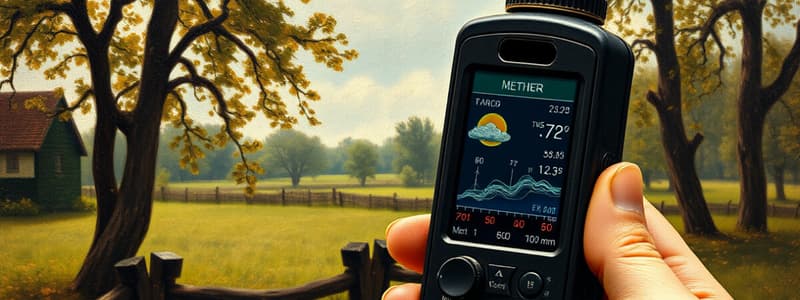Podcast
Questions and Answers
What must be done first to ensure correct pressure values when using an altitude or QNH reference?
What must be done first to ensure correct pressure values when using an altitude or QNH reference?
- Select the altitude screen and set the known pressure if QNH is available. (correct)
- Enter the reference altitude prior to adjusting the pressure settings.
- Directly input the currently measured air pressure into the system.
- Calibrate the wind impeller before adjusting pressure values.
Which step is unnecessary when measuring wind speed using the Pocket Weather Tracker?
Which step is unnecessary when measuring wind speed using the Pocket Weather Tracker?
- Engaging the system with a rubber band when preparing for data download.
- Standing outside facing the windward side for a specific duration.
- Adjusting the wind impeller cover before use. (correct)
- Utilizing the up/down buttons to change display modes.
When performing a reference altitude setting after obtaining a current altitude, which screen should be accessed?
When performing a reference altitude setting after obtaining a current altitude, which screen should be accessed?
- BARO screen to enter the reference altitude. (correct)
- Wind screen to calibrate wind measurements based on altitude.
- Pressure screen to adjust the currently set QNH.
- Data download screen to save current altitude readings.
How is reference pressure determined if an altitude value is known?
How is reference pressure determined if an altitude value is known?
What is an essential step in downloading data from a Pocket Weather Tracker to a computer?
What is an essential step in downloading data from a Pocket Weather Tracker to a computer?
Which measurements can the Pocket Weather Tracker provide regarding wind speed?
Which measurements can the Pocket Weather Tracker provide regarding wind speed?
What is the correct procedure for calibrating the digital compass on the Pocket Weather Tracker?
What is the correct procedure for calibrating the digital compass on the Pocket Weather Tracker?
When setting up the Pocket Weather Tracker, which setting is crucial for accurate barometric pressure and altitude readings?
When setting up the Pocket Weather Tracker, which setting is crucial for accurate barometric pressure and altitude readings?
What should be done when the Pocket Weather Tracker is switched on for the first time?
What should be done when the Pocket Weather Tracker is switched on for the first time?
What happens if the digital compass of the Pocket Weather Tracker is not calibrated properly after battery replacement?
What happens if the digital compass of the Pocket Weather Tracker is not calibrated properly after battery replacement?
Flashcards are hidden until you start studying
Study Notes
Meteorological Elements Measured by Pocket Weather Tracker
- Measures wind direction and speed
- Records cross wind, head wind, and tail wind
- Tracks dry bulb and dew point temperatures
- Calculates wind chill effects
- Assesses relative humidity levels
- Evaluates heat stress conditions
- Monitors barometric pressure
- Measures altitude and density altitude
Setting up the Pocket Weather Tracker
- Insert batteries securely using plastic shim to hold them in place
- Set date and time during first use or battery replacement
- Calibrate the digital compass after each battery replacement to ensure accurate readings:
- Power on and select compass calibration
- Hold upright and rotate slowly three times
- Calibration confirmation displayed
- Set barometric pressure and altitude:
- Use station pressure to calculate altitude and adjust for accurate readings
- Input QNH or altitude as a reference for pressure calculations
- After setups, system readiness confirmed.
Operating Procedure
- Remove cover of wind impeller before use
- Stand windward for three minutes to gather data effectively
- Use up/down buttons to view different element readings
Data Downloading Procedure
- Insert PWT into Interface and secure with rubber band
- Connect RS-232 cable to computer's USB port
- Start the computer and select the Kestrel Communicator program, installing from CD if necessary
- Monitor uploading progress → takes approximately 2½ minutes
- Save uploaded data on the computer for future reference and add remarks if needed
Loading and Clearing Data
- Previously saved remarks displayed while loading saved data
- Clear the Kestrel Tracker memory with confirmation request
Observations at Operational Location
- Met Assistant uses Pocket Weather Tracker for current weather observations where conventional observatories are unavailable
- Data is either downloaded directly to a computer or stored within the device
- Regular maintenance recommended: clean with a soft cloth and check battery voltage frequently
Studying That Suits You
Use AI to generate personalized quizzes and flashcards to suit your learning preferences.



